Coinage Act is a stock short title used for legislation in the United Kingdom and the United States related to coinage.

Dollar is the name of more than 20 currencies. The United States dollar, named after the international currency known as the Spanish dollar, was established in 1792 and is the first so named that still survives. Others include the Australian dollar, Brunei dollar, Canadian dollar, Eastern Caribbean dollar, Hong Kong dollar, Jamaican dollar, Liberian dollar, Namibian dollar, New Taiwan dollar, New Zealand dollar, Singapore dollar, Trinidad and Tobago Dollar and several others. The symbol for most of those currencies is the dollar sign $ in the same way as many countries using peso currencies. The name "dollar" originates from Bohemia and a 29 g silver-coin called the Joachimsthaler.
Coins of the United States dollar were first minted in 1792. New coins have been produced annually and they make up a valuable aspect of the United States currency system. Today, circulating coins exist in denominations of 1¢, 5¢, 10¢, 25¢, 50¢, and $1.00. Also minted are bullion and commemorative coins. All of these are produced by the United States Mint. The coins are then sold to Federal Reserve Banks which in turn are responsible for putting coins into circulation and withdrawing them as demanded by the country's economy.

The Coinage Act of 1873 or Mint Act of 1873, was a general revision of laws relating to the Mint of the United States. By ending the right of holders of silver bullion to have it coined into standard silver dollars, while allowing holders of gold to continue to have their bullion made into money, the act created a gold standard by default. It also authorized a Trade dollar, with limited legal tender, intended for export, mainly to Asia, and abolished three small-denomination coins. The act led to controversial results and was denounced by critics as the "Crime of '73".

Sterling is the currency of the United Kingdom and nine of its associated territories. The pound is the main unit of sterling, and the word "pound" is also used to refer to the British currency generally, often qualified in international contexts as the British pound or the pound sterling. In British English, its most common nickname is "quid."
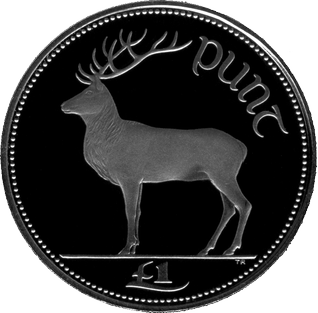
The pound was the currency of the Republic of Ireland until 2002. Its ISO 4217 code was IEP, and the symbol was £. The Irish pound was replaced by the euro on 1 January 1999. Euro currency did not begin circulation until the beginning of 2002.

A nickel is a five-cent coin struck by the United States Mint. Composed of cupronickel, the piece has been issued since 1866. Its diameter is 0.835 inches (21.21 mm) and its thickness is 0.077 inches (1.95 mm).

The United States Mint is a bureau of the Department of the Treasury responsible for producing coinage for the United States to conduct its trade and commerce, as well as controlling the movement of bullion. It does not produce paper money; that responsibility belongs to the Bureau of Engraving and Printing. The first United States Mint was created in Philadelphia in 1792, and soon joined by other centers, whose coins were identified by their own mint marks. There are currently four active coin-producing mints: Philadelphia, Denver, San Francisco, and West Point.

The dime, in United States usage, is a ten-cent coin, one tenth of a United States dollar, labeled formally as "one dime". The denomination was first authorized by the Coinage Act of 1792.

The eagle was a United States $10 gold coin issued by the United States Mint from 1792 to 1933.

The Coinage Act of 1792, passed by the United States Congress on April 2, 1792, created the United States dollar as the country's standard unit of money, established the United States Mint, and regulated the coinage of the United States. This act established the silver dollar as the unit of money in the United States, declared it to be lawful tender, and created a decimal system for U.S. currency.
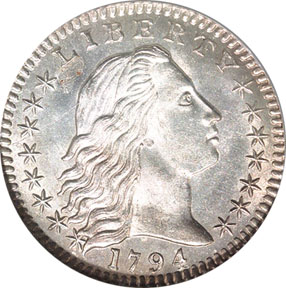
The half dime, or half disme, was a silver coin, valued at five cents, formerly minted in the United States.

The pound was the currency of Australia from 1910 until 14 February 1966, when it was replaced by the Australian dollar. Like other £sd currencies, it was subdivided into 20 shillings, each of 12 pence.

The American twenty-cent piece is a coin struck from 1875 to 1878, but only for collectors in the final two years. Proposed by Nevada Senator John P. Jones, it proved a failure due to confusion with the quarter, to which it was close in both size and value.
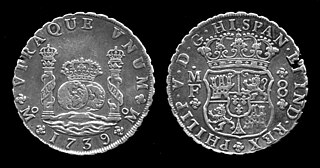
The silver standard is a monetary system in which the standard economic unit of account is a fixed weight of silver. Silver was far more widespread than gold as the monetary standard worldwide, from the Sumerians c. 3000 BC until 1873. Following the discovery in the 16th century of large deposits of silver at the Cerro Rico in Potosí, Bolivia, an international silver standard came into existence in conjunction with the Spanish pieces of eight. These silver dollar coins played the role of an international trading currency for nearly four hundred years.
From c. 1124 until 1709 the coinage of Scotland was unique, and minted locally. A wide variety of coins, such as the plack, bodle, bawbee, dollar and ryal were produced over that time. For trading purposes coins of Northumbria and various other places had been used before that time; and since 1709 those of the Kingdom of Great Britain, and then of the UK.

The Coinage Act of 1965, Pub. L. 89–81, 79 Stat. 254, enacted July 23, 1965, eliminated silver from the circulating United States dime and quarter dollar coins. It also reduced the silver content of the half dollar from 90 percent to 40 percent; silver in the half dollar was subsequently eliminated by a 1970 law.

The United States dollar is the official currency of the United States and several other countries. The Coinage Act of 1792 introduced the U.S. dollar at par with the Spanish silver dollar, divided it into 100 cents, and authorized the minting of coins denominated in dollars and cents. U.S. banknotes are issued in the form of Federal Reserve Notes, popularly called greenbacks due to their predominantly green color.
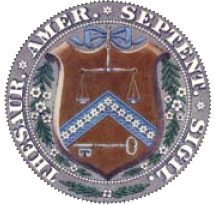
The United States Assay Commission was an agency of the U.S. federal government from 1792 to 1980. Its function was to supervise the annual testing of the gold, silver, and base metal coins produced by the United States Mint to ensure that they met specifications. Although some members were designated by statute, for the most part the commission, which was freshly appointed each year, consisted of prominent Americans, including numismatists. Appointment to the Assay Commission was eagerly sought after, in part because commissioners received a commemorative medal. These medals, different each year, are extremely rare, with the exception of the 1977 issue, which was sold to the general public.
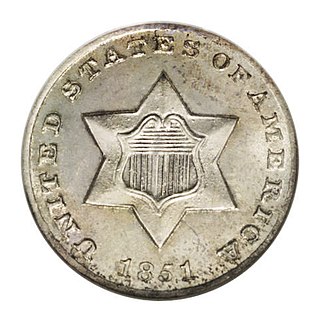
The three-cent silver, also known as the three-cent piece in silver or trime, was struck by the Mint of the United States for circulation from 1851 to 1872, and as a proof coin in 1873. Designed by the Mint's chief engraver, James B. Longacre, it circulated well while other silver coinage was being hoarded and melted, but once that problem was addressed, became less used. It was abolished by Congress with the Coinage Act of 1873.

The Coinage Act of 1853, 10 Stat. 160, was a piece of legislation passed by the United States Congress which lowered the silver content of the silver half dime, dime, quarter dollar, and half dollar, and authorized a three dollar gold piece. Although intending to stabilize the country's silver shortage, it, in effect, pushed the United States closer to abandoning bimetallism entirely and adopting the gold standard.